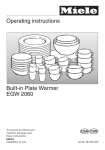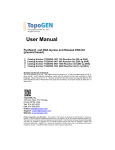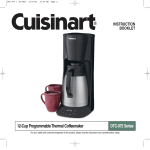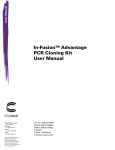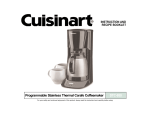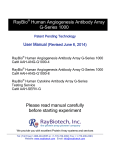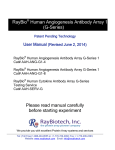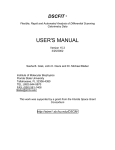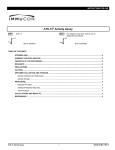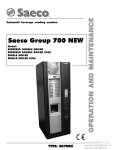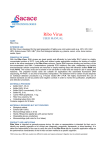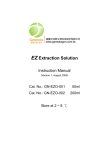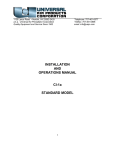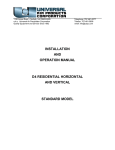Download Plasmid Fast Midiprep Kit
Transcript
Plasmid Fast Midiprep Kit (High quality Plasmid Purification Kits for Transfection) User Manual Version 6.0 Catalog No. 11510F/11520F/11500F Storage Conditions: Room Temperature For Research Use Only www.mbiotech.co.kr Principle The m.biotech High quality Plasmid Purification Kits for Transfection procedure is based on a modified alkaline lysis method, followed by binding of plasmid DNA onto membrane in the presence of low-salt and pH conditions. RNA, proteins, dyes, and low-molecular-weight impurities are removed by a medium-salt wash. Plasmid DNA is eluted in a high-salt buffer and the concentrated and desalted by isopropanol precipitation. No expensive equipment such as ultracentrifuges and HPLC, or toxic reagents, such as phenol and ethidium bromide are required. Culture volume Do not exceed the maximum recommended culture volumes given at the beginning of each protocol. Using larger culture volumes will lead to an increase in biomass and can affect the efficiency of alkaline lysis, leading to reduced yield and purity of the preparation. The protocol for High quality Plasmid Purification Kits for Transfection is optimized for use with cultures grown in standard Luria Bertani (LB) medium, grown to a cell density of approximately 3–4 x 109 cells per ml. We advise harvesting cultures after approximately 12–16 hours of growth, which typically is the transition from logarithmic into stationary growth phase. It is best to assess the cell density of the culture, and if that is too high, reduce the culture volumes accordingly or increase the volumes of Buffer T1, Buffer T2, Buffer T3. A high ratio of biomass to lysis buffers will result in poor lysis conditions and subsequently low DNA yield and purity. For determination of cell density calibration of each individual spectrophotometer is required to facilitate accurate conversion of OD600 measurements into the number of cells per ml. This can be achieved by plating serial dilutions of a culture onto LB-agar plates in the absence of antibiotics. The counted colonies are used to calculate the number of cells per ml, which is then set in relation to the measured OD600 values. Convenient stopping points in protocols The purification procedure can be stopped and continued later by freezing the cell pellets obtained by centrifugation. The frozen cell pellets may be stored at –20°C for several weeks. In addition, the DNA eluted from the Spin- or Ez-Column may be stored overnight at 2–8°C, after which the protocol can be continued. Important Note Please read the following notes before starting any of the Plasmid Purification procedures for Transfection. Plasmid Fast Midiprep Kit 1 Before equipment ● Add the RNase A Solution to Buffer T1, mix, store at 2-8℃. ● Check Buffer T2 before use for salt precipitation. If any precipitated, heat to dissolve (37℃). Wear, gloves when handling these buffer. ● Isopropanol and 70% ethanol. ● In Spin-Column, If remainder should occur Plasmid Fast Midiprep Kit 2 Protocol for Plasmid Fast Midiprep Kit (Reusable High quality Plasmid Purification Kits for Transfection) Please read “Important Notes” before starting. Cat. No. 11510F 11520F 11500F Storage 10 preps 25 prep 100 preps Condition Buffer EQ 50 ml 125 ml 250 ml X 2ea RT Buffer T1 50 ml 125 ml 125 ml X 4ea RT Buffer T2 50 ml 125 ml 250 ml X 2ea RT Buffer T3 50 ml 125 ml 250 ml X 2ea RT Buffer TU 125 ml 125 ml X 2ea 250 ml X 4ea RT 60 ml X1 125 ml X 1ea Buffer EN 50 ml 125 ml 250 ml X 2ea RT Buffer TE 5 ml 12 ml 60 ml RT RNase A (25mg/ml) 250 ul 60 ul 600 600 ul X 4ea 4℃ Midi Column & Tube Each 10 ea Each 25 ea Each 100 ea RT 1 ea 1 ea 1 ea - Protocol Plasmid Fast Midiprep Kit 3 1. Harvest a 50 ml cultured high-copy-number plasmids or cosmids (>2 μg DNA/ml LB). If you wish to stop the protocol and continue later, freeze the cell pellets at -20°C. 2. Apply 5 ml of Buffer EQ to the Midi-Column. Let stand for 1 min. Centrifuge at ≥ 4,000 x g in a swing-bucket rotor at room temperature for 1 min or vacuum. OR centrifuge at ≥ 8,000 x g in a fixed-angle rotor for 3 min (disregard of remainder, next step). Discard the flow-through. 3. Suspend pelleted bacterial cells in 5 ml of Buffer T1. 4. Add 5 ml of Buffer T2. Mix gently by inverting the capped tube five times. Do not vortex. Incubate at room temperature for 5 min. 5. Add 5 ml of Buffer T3. Mix immediately by inverting the tube five times. Do not vortex. 6. Centrifuge at ≥ 15,000 x g at room temperature for 10 min. If centrifugation is done at 4°C, supernatant must be warmed to room temperature before loading on column. 7. Apply the cleared lysate of step 6 into the equilibrated Midi-Column. Centrifuge at ≥ 4,000 x g in a swing-bucket rotor at room temperature for 1 min or vacuum. OR centrifuge at ≥ 8,000 x g in a fixed-angle rotor for 3 min (disregard of remainder, next step). Discard the flow-through. 8. Apply 12 ml of Buffer TU to the Midi-Column. Centrifuge at ≥ 4,000 x g in a swing-bucket rotor at room temperature for 2 min or vacuum. OR centrifuge at ≥ 8,000 x g in a fixed-angle rotor for 3 min (disregard of remainder, next step). Discard the flow-through. 9. Place the Midi-Column in a clean 50 ml centrifuge tube (not provided). Apply 5 ml of Buffer EN to the Midi-Column. Centrifuge at ≥ 4,000 x g in a swing-bucket rotor at room temperature for 2 min. OR centrifuge at ≥8,000 x g in a fixed-angle rotor for 3 min (disregard of remainder, next step). Note: For constructs larger than 45–50 kb, prewarming the Buffer EN to 65°C may help to increase yield. Plasmid Fast Midiprep Kit 4 10. Precipitate DNA by adding 0.7 volume isopropanol to the eluted DNA. Mix and centrifuge at ≥ 15,000 x g at 4°C for 30 min. carefully discard the supernatant. 11. Wash DNA pellet with 2 ml 70% ethanol. Centrifuge at ≥ 15,000 x g at 4°C for 10 min. Carefully and fully pipet off the ethanol wash without disturbing the pellet. Air-dry the pellet. 12. Redissolve the DNA in 0.4 ml or a suitable volume of Buffer TE, pH 8.0 or 10 mM Tris-Cl, pH8.5. Plasmid Fast Midiprep Kit 5 Troubleshooting Guiade This troubleshooting guide may be helpful in solving any problems that may arise. Problem Comments and suggestions Low or no DNA yield No DNA in lysate a) Plasmid did not Check the conditions for optimal growth. Propagate b) Alkaline lysis was If cells have grown to very high densities or a larger amount of Inefficient cultured medium than recommended was used, the ratio of biomass to lysis reagent is shifted. This may result in poor lysis conditions, because the volumes of Buffer T1, T2, and T3 are not sufficient for setting the plasmid DNA free efficiently. Reduce culture volume or increase volumes of Buffer T1, T2, and T3. Also insufficient mixing of lysis reagents will result in reduced yield. c) Insufficient lysis for low-copy plasmids For low-copy plasmid preparations, doubling the volumes of Buffers T1, T2, and T3 may help to increase plasmid yield and quality. d) Lysate incorrectly prepared Check Buffer T2 for SDS precipitation resulting from low storage temperatures and dissolve the SDS by warming. DNA is found in the flow-through of cleared lysate a) Plasmid Purification If rich culture media, such as TB or 2x YT are used, culture membrane overloaded volumes must be reduced. It may be necessary to adjust LB culture volume if the plasmid and host strain show extremely high copy number or growth rates. b) RNase A digestion Ensure that RNase A is added to Buffer T1 before use. omitted c) RNase A digestion Reduce culture volume if necessary. If Buffer T1 containing Insufficient RNase A is more than 6 months old, add additional RNase A. d) SDS was in lysate Buffer T3 before use. If lysate is too viscous for effective mixing of Buffer T3, reduce culture volume or increase volumes of Buffer T1, T2, and T3. No DNA in eluate a) No DNA in the lysate See section “No DNA in lysate” b) DNA passed through in See previous two sections. the flow-through or wash Plasmid Fast Midiprep Kit 6 fraction Little or no DNA after precipitation a) DNA failed to precipitate Ensure that the precipitate is centrifuged at ≥15,000 x g for 30 min. Recover DNA by centrifuging for longer and at higher speeds. Try another isopropanol batch. b) DNA pellet was lost Isopropanol pellets are glassy and may be difficult to see. Mark the outside of the tube before centrifugation. Isopropanol pellets may also be loosely attached to the side of the tube, so pour supernatant off gently. c)DNA was poorly redissolved Check that DNA is completely redissolved. Be sure to wash any DNA off the walls, particularly if glass tubes and a fixed-angle rotor are used. Up to half of the total DNA may be smeared on the walls. Alternatively, a swinging bucket rotor can be used to ensure that the pellet is located at the bottom of the tube. Plasmid DNA difficult to redissolve a) Pellet was overdried Air-dry pellet instead of using a vacuum, especially if the DNA is of high molecular weight. Redissolve DNA by warming the solution slightly, and allowing more time for redissolving. b) Residual isopropanol Ensure that pellets are washed with 70% ethanol to remove in pellet traces of isopropanol. Redissolve DNA by warming the solution slightly, and allowing more time for redissolving. Increase volume of buffer used for redissolving if necessary. c) Too much salt Ensure that isopropanol is at room temperature for precipitation, in pellet and wash the pellet twice with room temperature 70% ethanol. Recover DNA by increasing the volume of buffer used for redissolving. d) Buffer pH was too low Ensure that the pH of the buffer used for redissolving is ≥8.0, since DNA does not dissolve well in acidic solutions. e) Resuspension (T1) Increase resuspension (T1) volume if the solution above the volume too low pellet is highly viscous. Contaminated DNA/poor-quality DNA a)Genomic DNA in the eluate Mixing of bacterial lysate was too vigorous. The lysate must be handled gently after additional Buffer T1, T2 and T3 to prevent shearing of chromosomal DNA. Reduce culture volume if lysate is too viscous for gentle mixing. b) RNA in the eluate RNase A digestion was insufficient. Check culture volume against recommended volumes, and reduce if necessary. Check that the RNase A provided with the kit has been used. Plasmid Fast Midiprep Kit 7 If Buffer T1 is more than 6 months old, add more RNase A. c) Nuclease contamination Check buffers for nuclease contamination and replace if necessary. Use new glass- and plasticware, and wear gloves. d) Lysis time was too Ensure that lysis step (Buffer T2) does not exceed 5 min. Long e) Overloaded alkaline lysis Check the culture volume and yield against the capacity of the SpinColumn. Reduce the culture volume accordingly or alternatively increase the volume of Buffer T1, T2, and T3. f) Plasmid DNA is DNA was poorly buffered. Redissolve DNA in Buffer TE, pH 8.0, to inhibit nicked/sheared/Degraded nuclease activity and maintain stable pH during storage. g) Shearing during Redissolve DNA gently, without vortexing or vigorous pipetting. Redissolving Avoid using small pipet tips. h) Particles in Centrifuge the DNA solution and transfer supernatant to a new redissolved DNA tube. The particles have no affect on DNA quality. Alternatively, use UltraHiFast kits containing Precipitatior, which filters the eluate. Poor DNA performance a) Too much salt in pellet Ensure that isopropanol is at room temperature for precipitation, and wash the pellet twice with room temperature 70% ethanol. Precipitate the DNA again to remove the salt. b) Residual protein Check culture volume against the recommended volumes and reduce if necessary. Ensure that the bacterial lysate is cleared properly by centrifugation at ≥15,000 x g for 45 min, or using a Cartridge. Extra DNA bands on analytical gel a) Dimer form of plasmid Dimers or multimers of supercoiled plasmid DNA are formed during replication of plasmid DNA. Typically, when purified plasmid DNA is electrophoresed, both the supercoiled monomer and dimer form of the plasmid are detected upon ethidium bromide staining of the gel. The ratio of these forms is often host dependent. b) Plasmid has formed This species runs faster than closed circular DNA on a gel and is Denatured supercoils resistant to restriction digestion. Do not incubate cells for longer than 5 Plasmid Fast Midiprep Kit 8 min in Buffer T2. Mix immediately after addition of Buffer T3. c) Possible deletion Some sequences are poorly maintained in plasmids. Check for mutants deletions by restriction analysis. Cosmid clones, in particular, should always be prepared from freshly streaked, well-isolated colonies, since cosmids are not stable in E. coli for long periods of time. Blocked Spin-Column Ensure that the lysate is clear before it is loaded onto the column. a) Lysate was turbid Ensure that Buffer T3 is chilled before use. Check g-force and centrifugation time. Alternatively, clear the lysate using a Cartridge. To clear a blocked Spin-Column, positive pressure may be applied (e.g., by using a syringe fitted into a rubber stopper with a hole). Cartridges Cartridge clogs during filtration a)Too large culture Use no more than the culture volume recommended in the volume used protocol. b) Inefficient mixing after Mix well until a fluffy white material has formed and the lysate is addition of Buffer T3 no longer viscous. c) After Mixing too vigorous after addition of Buffer T3 addition of Buffer T3 the lysate should be mixed immediately but gently. Vigorous mixing disrupts the precipitate into tiny particles which may clog the Cartridge. d) Cartridge was not After addition of Buffer T3 the lysate should be poured loaded immediately after immediately into the Cartridge. Decanting after incubation may addition of Buffer T3 disrupt the precipitate into tiny particles which may clog the Cartridge. e) Cartridge was agitated Pour the lysate into the Cartridge immediately after addition of during incubation Neutralization Solution and do not agitate during the 10 min incubation. Agitation causes the precipitate to be disrupted into tiny particles, instead of forming a layer. f) Incubation after addition Ensure incubation is performed at room temperature Buffer T3 on of Buffer T3 on ice instead ice instead of in the Cartridge. Precipitate flotation is more of at RT efficient at room temperature than on ice. g) Incubation time after Incubate with Buffer T3 as indicated in the protocol. If the addition of Buffer T3 too precipitate has not risen to the top after the 10 min incubation, short carefully run a sterile pipet tip or sterile spatula around the cartridge wall to dislodge the precipitate before continuing with the filtration. Plasmid Fast Midiprep Kit 9 Lysate not clear after filtration a) Precipitate was forced Filter until all of the lysate has passed through the Midi or Maxi through the Cartridge, but do not apply extreme force. Approximately 12 ml Catridge (Midi) or 25 ml (Maxi) of the lysate are typically recovered. Precipitator Modules DNA does not perform well a) Eluate contains Ensure that the membrane is dried by pressing air through the residual alcohol Precipitator at least twice. Dry the outlet nozzle of the Precipitator with absorbent paper. Precipitator clogs during use a) Too much DNA applied Do not load eluate from several columns on the Precipitator. to the Precipitator b) Precipitator Midi Use the size of Precipitator corresponding to the Spin-Column Module was used for being used. precipitation of eluate from a column c) Ethanol was used for Use of ethanol instead of isopropanol for precipitation leads to a precipitation instead finer precipitate that can clog the module. of isopropanol Precipitator casing breaks, causing leakage a) Excessive exposure of Prolonged incubation with alcohol may weaken the joint between Precipitator to alcohol upper and lower part of the Precipitator. Complete steps 15~20 within 10~15 min. b) Precipitator attached Do not apply excessive force, bending, or twisting when attaching with excessive force the Precipitator to the syringe. c) Precipitator inlet was Do not stress the inlet by resting one edge of the Precipitator on bent during processing a hard surface (e.g., the edge of a sink) and depressing the syringe plunger. Always apply perpendicularly to the Precipitator. Plasmid Fast Midiprep Kit 10 gentle, even, pressure Customer & Technical Services For technical assistance and more information please contact us. www.mbiotech.co.kr Tel : +82-31-556-3905 Fax : +82-31-790-0079 E-mail : [email protected] Plasmid Fast Midiprep Kit 11












